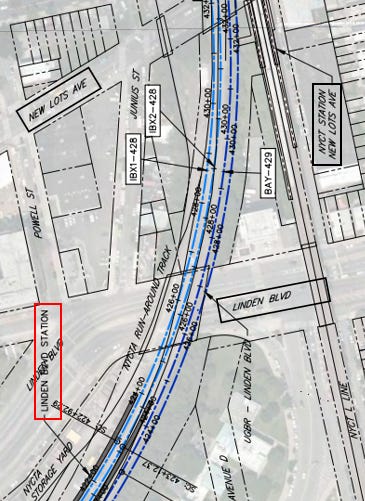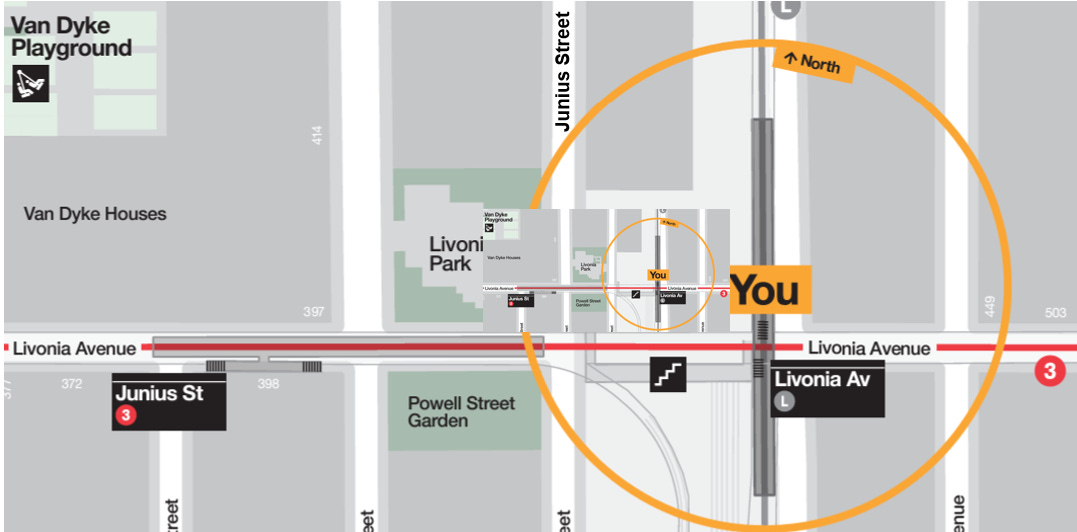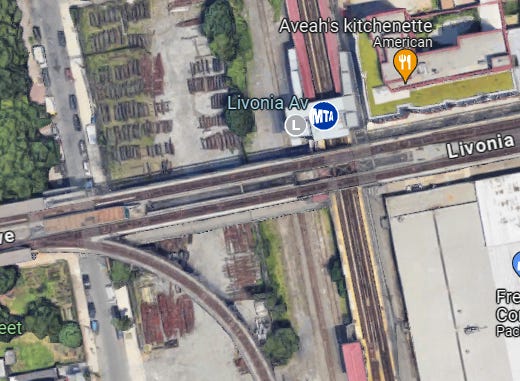The proposed Interborough Express (IBX) line runs parallel to the Canarsie (L) subway line from Linden Boulevard to Wilson Avenue. Currently, the MTA plans to provide transfers between the IBX and L lines at five stations in that section. Is it really a good idea to have IBX stations at Linden Boulevard, Sutter Avenue and Wilson Avenue? Or would it be better to omit those stations and provide enhanced transfer connections at Livonia Avenue and Broadway Junction? Would less stations also be more consistent with making the IBX an Express line?
In my opinion, fast and convenient transfers are a key to the success of the IBX line. But, there do not need to be five transfer stations between the IBX and L trains. I suggest that two transfer stations could be better and actually more convenient. I have written recently that a Broadway Junction IBX station, with an entrance at Atlantic Avenue, would be a better multi-line transfer station than an IBX Atlantic Avenue station.[2] In the present article, I discuss four other IBX stations suggested by the MTA. I suggest omitting three of them and enhancing transfers at the fourth station, Livonia Avenue.
Linden Boulevard & New Lots Avenue Stations
Linden Boulevard is a wide highway (NY Route 27) running east-west in south Brooklyn. The relevant section separates the neighborhoods of Brownsville and Canarsie. There is no bus route or subway line along Linden Boulevard.
North of Linden Boulevard, the IBX right-of-way (ROW) and the Canarsie (L) line run parallel for approximately two-and-a-quarter miles. Heading south, the tracks diverge just before Linden Boulevard. The L line continues generally south for two stops to Canarsie-Rockaway Parkway station, where there also is a bus terminal. The IBX ROW runs past the NYC Transit Linden Yard and Iron Shop, where heavy track maintenance is done,[3] as it turns west toward Bay Ridge.
The nearest L line station to Linden Boulevard is named “New Lots Avenue.” It is located between Linden Boulevard and New Lots Avenue. The east-west B35 bus route is on New Lots Avenue, running past the station entrance on that avenue.
The MTA consultants have proposed a “Linden Boulevard” IBX station south of Linden Boulevard, as indicated in the red box on the map above.
That is not a very good station location for several reasons. First, transferring IBX riders would have to cross the 10-plus lanes of Linden Boulevard when going to or from the L line’s New Lots Avenue station. Second, there are few residences south of Linden Boulevard in the immediate vicinity of the proposed IBX station. Few transit trips are likely to start or end there.
A third reason is that the MTA consultants have reported there is limited space at this location to provide for access to the station, including the stairways, elevators and escalators needed to get passengers from their point of access to the platform.[4]
While the IBX ridership data predicts a total of over 8,000 weekday on-offs at a Linden Boulevard station,[5] it appears to me that this estimate is based on approximately 90% transfers, which could be made at another station. The planners did not appear to have considered the inconvenience and time necessary to cross Linden Boulevard to and from the L line station, and—therefore—have probably greatly overestimated the number of transfers at a possible Linden Boulevard IBX station. Transfer could be faster and more convenient at Livonia Avenue, one stop to the north, as discussed next.
Livonia Avenue Station
The existing, elevated Livonia Avenue station on the Canarsie (L) line is one stop north of New Lots Avenue, adjoining the IBX ROW, which is to the west of the Canarsie line, in a cut below street level. The number 3 line to its New Lots Avenue terminal passes overhead along Livonia Avenue. It has a station entrance a bit over one block west of Junius Street.
Although a very expensive elevator structure has recently been completed at the existing Livonia Avenue (L) station, the ~650-foot transfer to the number 3 line is still poor. A pedestrian bridge (indicated by a stairs symbol on the map below) passes over the IBX ROW from to Livonia Avenue (L) station to Junius Street, where stairs go down to the sidewalk. Transferring riders must then walk to entrance and climb up the stairway to the Junius Street (3) station.
(The Junius Street station is listed for ADA improvements, including elevators.[6] I expect that the pedestrian bridge will be extended to that station at the same time, as has been long promised.)
All of the above indicates that Livonia Avenue would be a good location for an IBX transfer station. Because the IBX line runs in a cut, and the L and 3 lines are elevated, a connecting structure with stairs, elevators and—preferably—escalators will be required. That could be built straddling above the IBX and freight tracks in the cut, either to the north or south of Livonia Avenue. (See aerial photo below):
Sutter Avenue Station
It is not clear to me why the MTA’s consultants proposed an IBX station at Sutter Avenue, adjacent to the Canarsie (L) line station there. That location is less than a quarter-mile from the proposed Livonia Avenue IBX station. Indeed, the proposed IBX stations at Livonia and Sutter Avenues would be closer than the existing Canarsie (L) line stations, as shown below:
One possible reason for considering a Sutter Avenue IBX station is that the east-east B14 bus route crosses those transit lines on Sutter Avenue. However, as shown in light blue on the Brooklyn bus map below, that line also goes within one block of the Junius Street (3) station. It appears the bus route easily could be moved to run on Livonia Avenue for an even more easy connection to the Livonia Avenue transfer station.
With transfer stations on either side, at Livonia Avenue and Broadway Junction, the Sutter Avenue IBX station appears unnecessary.
Broadway Junction (not Atlantic Avenue) Station
An IBX station should be located at Broadway Junction with an entrance from the Long Island Railroad (LIRR) at Atlantic Avenue, as I have suggested in previous articles.[7] Broadway Junction already is a major subway and bus transfer station, which is now scheduled for ADA improvements at considerable expense.[8] It makes sense to provide transfers with the IBX line there if that would be practical and if a convenient connection with the LIRR can be provided. As indicated in my past articles, I suggest that can and should be done.
Wilson Avenue Station
The existing Canarsie (L) line station is the northernmost station where the IBX and L lines are parallel. The B20 and B60 bus routes are within five minutes’ walk from there. For those reasons, an IBX station there might be appropriate. However, the MTA consultants found more than the usual obstacles there.
The Wilson Avenue station, shown above, is listed on the National Register of Historic Places.[9]
The station’s arrangement is unusual. As shown in the map below, the entrance building is on the north side of the freight ROW, where the IBX line would run. The Canarsie (L) line tracks are on the south side of that ROW, next to the cemetery. The northbound tracks (which soon turn west towards Manhattan) are in a tunnel, connected to the entrance building by a passageway under the freight ROW. The southbound platform is on the surface, above the northbound tracks.[10]
The MTA’s Interim Report stated, regarding an IBX station at Wilson Avenue, “Local street access is complicated by the presence of the Evergreens Cemetery,”[11] “The present configuration of the embankment … limits the currently available space for tracks and pedestrian access elements”[12] and that “limited space … complicate[s] station design.”[13]
Regarding buses, the B20 bus route passes the Broadway Junction station, providing a more convenient transfer there than at Wilson Avenue.
CONCLUSION
It is not necessary to build Interborough Express stations at most of the Canarsie (L) line stations where the tracks of the two lines are adjoining. IBX stations can be omitted at Wilson Avenue, Atlantic Avenue, Sutter Avenue and Linden Boulevard. Some of the savings can be used to optimize the speed and convenience of transfers between the IBX and other lines at Broadway Junction and Livonia Avenue stations.
As usual, a PDF copy of this article is attached.
This article expresses the personal views of the author and does not express the views of his employer, or any client or organization. The author has degrees in law and physics, and has taken several engineering courses. After five years of work as an engineer, he has practiced law primarily in the field of patents for over 50 years, dealing with a wide variety of technologies. He is a life-long railfan and user of public transportation in the United States, Europe and Japan.
[1] © John Pegram 2024.
[2] https://bqrail.substack.com/p/there-should-be-a-broadway-junction and https://bqrail.substack.com/p/an-atlantic-avenue-entrance-to-the.
[3] Dougherty, Tracks of the New York City Subway, 2024, pp. 33, 37. _____
[4] MTA, Interborough Express—Feasibility Study and Alternatives Analysis: Interim Report (Interim Report), Appendix 1.5 at pp. 30, 57 [260/1041, 287/10]. Citations in the form “[###/1041]” are to the version of the Interim Report with Appendices that is available at https://www.dropbox.com/scl/fi/i19338ojklzhjwap9cubd/IBX-Interim-Report-with-Appx-vol-1..pdf?rlkey=yxggrw7kplw40xtri1q7l9n7h&dl=0
[5] See MTA ridership document, attached.
[6] https://new.mta.info/project/station-accessibility-upgrades.
[7] Supra, note 2.
[8] https://new.mta.info/document/131491 at p. 5.
[9] https://catalog.archives.gov/id/75313339.
[10] Dougherty, supra, note 3 at p. 29.
[11] Interim Report, Appendix 1.5 at p. 68 [298/1041].
[12] Id. at p. 30 [260/1041].
[13] Id. at p. 57 [287/1041].











